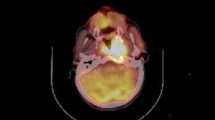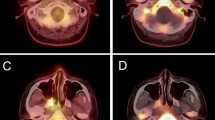Abstract
Purpose
This study was undertaken to evaluate the utility of whole-body 18F-FDG PET in monitoring therapeutic effect during induction chemotherapy (IC) and in predicting prognosis in patients with locoregionally advanced nasopharyngeal carcinoma (NPC).
Methods
Fifty patients who had histologically proven, locoregionally advanced NPC without distant metastasis and had received IC were recruited in this study. The study cohort consisted of 19 females and 31 males (age 17–72 years, mean 45.9±11.9). Whole-body 18F-FDG PET was performed in each patient after completion of one (33 patients) or two (17 patients) courses of IC. Each patient was restaged on the basis of the 18F-FDG PET results. Patients who were downstaged to stage I or II were classified as major responders; the rest were classified as non-major responders.
Results
Only 1 of the 23 major responders subsequently developed local recurrence. At the time of data analysis, all major responders were alive; by contrast, of the 27 non-major responders, 15 had locoregional recurrence or distant metastasis and nine had died (seven of NPC and two of treatment-related complications). Kaplan-Meier survival analysis showed significantly longer recurrence-free survival and overall survival in major responders (56.4±9.2 and 58.1±2.2 months) as compared with non-major responders (33.7±23.2 and 44.7±20.0 months), with p<0.0001 and p=0.0024, respectively.
Conclusion
The results of this study suggest that early restaging by a single whole-body 18F-FDG PET scan after the first or second course of IC is useful for predicting therapeutic response and outcome in patients with locoregionally advanced NPC.





Similar content being viewed by others
References
Huang DP. Epidemiology of nasopharyngeal carcinoma. Ear Nose Throat J 1990;69:222–5
Oh JL, Vokes EE, Kies MS, Mittal BB, Witt ME, Weichselbaum RR, et al. Induction chemotherapy followed by concomitant chemoradiotherapy in the treatment of locoregionally advanced nasopharyngeal cancer. Ann Oncol 2003;14:564–9
Rischin D, Corry J, Smith J, Stewart J, Hughes P, Peters L. Excellent disease control and survival in patients with advanced nasopharyngeal cancer treated with chemoradiation. J Clin Oncol 2000;20:1845–52
Hong RL, Ting LL, Ko JY, Hsu MM, Sheen TS, Lou PJ, et al. Induction chemotherapy with mitomycin, epirubicin, cisplatin, fluorouracil, and leucovorin followed by radiotherapy in the treatment of locoregionally advanced nasopharyngeal carcinoma. J Clin Oncol 2001;19:4305–13
Price P, Jones T. Can positron emission tomography (PET) be used to detect subclinical response to cancer therapy? The EC PET Oncology Concerted Action and the EORTC PET Study Group. Eur J Cancer 1995;31A:1924–7
Young H, Baum R, Cremerius U, Herholz K, Hoekstra O, Lammertsma AA, et al. Measurement of clinical and subclinical tumour response using [18F]-fluorodexoyglucose and positron emission tomography: review and 1999 EORTC recommendation. Eur J Cancer 1999;35:1773–82
Spaepen K, Stroobants S, Dupont P, Van Steenweghen S, Thomas J, Vandenberghe P, et al. Prognostic value of positron emission tomography (PET) with fluorine-18 fluorodeoxyglucose ([18F]FDG) after first-line chemotherapy in non-Hodgkin’s lymphoma: is[18F]FDG-PET a valid alternative to conventional diagnostic methods? J Clin Oncol 2001;19:414–9
Spaepen K, Stroobants S, Dupont P, Vandenberghe P, Thomas J, de Groot T, et al. Early restaging positron emission tomography with 18F-fluorodeoxyglucose predicts outcome in patients with aggressive non-Hodgkin’s lymphoma. Ann Oncol 2002;13:1356–63
Kosgakoglu L, Cloemen M, Leonard JP, Kuji I, Zoe H, Goldsmith SJ. PET predicts prognosis after 1 cycle of chemotherapy in aggressive lymphoma and Hodgkin’s disease. J Nucl Med 2002;43:1018–27
Jansson T, Westlin JE, Ahlstrom H, Lilja A, Langstrom B, Bergh J. Positron emission tomography studies in patients with locally advanced and/or metastatic breast cancer: a method for early therapy evaluation? J Clin Oncol 1995;13:1470–7
Bassa P, Kim EE, Inoue T, Wong FC, Korkmaz M, Yang DJ, et al. Evaluation of preoperative chemotherapy using PET with fluorine-18-fluorodeoxyglucose in breast cancer. J Nucl Med 1996;37:931–8
Smith IC, Welch AE, Hutcheon AW, Miller ID, Payne S, Chilcott F, et al. Positron tomography using [18F]-fluorodeoxy-d-glucose to predict the pathologic response of breast cancer to primary chemotherapy. J Clin Oncol 2000;18:1679–88
Schelling M, Avril N, Nährig J, Kuhn W, Römer W, Sattler D, et al. Positron emission tomography using [18F]fluorodeoxyglucose for monitoring to primary chemotherapy in breast cancer. J Clin Oncol 2000;18:1689–95
Burcombe RJ, Makris A, Pittam M, Lowe J, Emmott J, Wong WL. Evaluation of good clinical response to neoadjuvant chemotherapy in primary breast cancer using [18F]-fluorodeoxyglucose positron emission tomography. Eur J Cancer 2002;38:375–9
Schulte M, Brecht-Krauss D, Werner M, Hartwig E, Sarkar MR, Keppler P, et al. Evaluation of neoadjuvant therapy response of osteogenic sarcoma using FDG PET. J Nucl Med 1999;40:1637–43
Franzius C, Bielack S, Flege S, Sciuk J, Jürgens H, Schober O. Prognostic significance of 18F-FDG and 99mTc-methylene diphosphonate uptake in primary osteosarcoma. J Nucl Med 2002;43:1012–7
Weber WA, Ott K, Becker K, Dittler HJ, Helmberger H, Avril NE, et al. Prediction of response to preoperative chemotherapy in adenocarcinomas of the esophagogastric junction by metabolic imaging. J Clin Oncol 2001;19:3058–65
Brücher B, Weber W, Bauer M, Fink U, Avril N, Stein HJ, et al. Neoadjuvant therapy of esophageal squamous cell carcinoma: response evaluation by positron emission tomography. Ann Surg 2001;233:300–9
Flamen P, Van Cutsem E, Lerut A, Cambier JP, Haustermans K, Bormans G, et al. Positron emission tomography for assessment of the response to induction chemotherapy in locally advanced esophageal cancer. Ann Oncol 2002;13:361–8
Ott K, Fink U, Becker K, Stahl A, Dittler HJ, Busch R, et al. Prediction of response to preoperative chemotherapy in gastric carcinoma by metabolic imaging: results of a prospective trial. J Clin Oncol 2003;21:4604–10
Weber WA, Petersen V, Schmidt B, Tyndale-Hines L, Link T, Peschel C, et al. Positron emission tomography in non-small-cell lung cancer: prediction of response to chemotherapy to quantitative assessment of glucose use. J Clin Oncol 2003;21:2651–7
Lowe VJ, Dunphy FR, Varvares M, Kim H, Wittry M, Dunphy CH, et al. Evaluation of chemotherapy response in patients with advanced head and neck cancer using [F-18]fluorodeoxyglucose positron emission tomography. Head Neck 1997;19:666–74
Kostakoglu L, Goldsmith SJ. PET in the assessment of therapy response in patients with carcinoma of the head and neck and of the esophagus. J Nucl Med 2004;45:56–68
Reisser C, Haberkom U, Dimitrakopulou-Strauss A, Seifert E, Strauss LG. Chemotherapeutic management of head and neck malignancies with positron emission tomography. Arch Otolaryngol Head Neck Surg 1995;121:272–6
Kaplan ES, Meier P. Non-parametric estimation from incomplete observations. J Am Stat Assoc 1958;58:457–81
Higashi K, Anaira CC, Wahl RL. Does FDG uptake measure proliferative activity of human cancer cells? in vitro comparison with DNA flow cytometry and tritiated thymidine uptake. J Nucl Med 1993;34:414–9
Duhaylongsod FG, Lowe VJ, Patz EF Jr, Vaughn AL, Coleman RE. Lung tumor growth correlates with glucose metabolism measured by fluoride-18 fluorodeoxyglucose positron emission tomography. Ann Thorac Surg 1995;60:1348–52
Wahl RL, Zasadny K, Helvie M, Hutchins GD, Weber B, Cody R. Metabolic monitoring of breast cancer chemohormonotherapy using positron emission tomography: initial evaluation. J Clin Oncol 1993;11:2101–11
Yen RF, Chen ML, Liu FY, Ko SC, Chang YL, Chieng PU, et al. False-positive 2-[F-18]-fluoro-2-deoxy-d-glucose positron emission tomography studies for evaluation of focal pulmonary abnormalities. J Formosan Med Assoc 1998;97:642–5
Schoder H, Yeung HW, Gonen M, Kraus D, Larson SM. Head and neck cancer: clinical usefulness and accuracy of PET/CT image fusion. Radiology 2004;231:65–72
Goerres GW, von Schulthess GK, Steinert HC. Why most PET of lung and head-and-neck cancer will be PET/CT. J Nucl Med 2004;45:66S–71S
Dressel S, Grammerstorff J, Schwenzer K, Brinkbaumer K, Schmid R, Pfluger T, et al. [18F]FDG imaging of head and neck tumours: comparison of hybrid PET and morphological methods. Eur J Nucl Med Mol Imaging 2003;30:995–1003
Bengel FM, Ziegler SI, Avril N, Weber W, Laubenbacher C, Schwaiger M. Whole-body positron emission tomography in clinical oncology: comparison between attenuation-corrected and uncorrected images. Eur J Nucl Med 1997;24:1091–8
Acknowledgements
The 18F-FDG used in this study was provided by National PET/Cyclotron Center, Taipei, Taiwan.
Author information
Authors and Affiliations
Corresponding author
Rights and permissions
About this article
Cite this article
Yen, RF., Chen, T.HH., Ting, LL. et al. Early restaging whole-body 18F-FDG PET during induction chemotherapy predicts clinical outcome in patients with locoregionally advanced nasopharyngeal carcinoma. Eur J Nucl Med Mol Imaging 32, 1152–1159 (2005). https://doi.org/10.1007/s00259-005-1837-5
Received:
Accepted:
Published:
Issue Date:
DOI: https://doi.org/10.1007/s00259-005-1837-5




